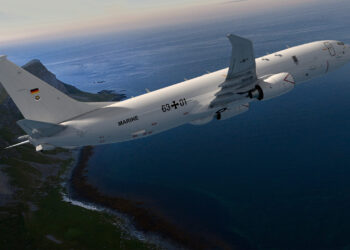, SOUTHAMPTON, UK: BAE Systems has today unveiled a revolutionary unmanned autonomous underwater system, Talisman M. One of a range of Talisman vehicles in development, the M classification denotes its mine countermeasures (MCM) role.
The size of a small family car, Talisman is known as an Unmanned Underwater Vehicle (UUV) and builds on innovative technology already incorporated in a previous variant and n the range of BAE Systems' unmanned aerial vehicles.
Andy Tonge, Talisman project manager at BAE Systems Underwater Systems said: “Talisman M can perform the type of dangerous roles currently performed by service men and women throughout the world – locate, identify and neutralise mines in one single mission without the need for human intervention. Using technology from the non-defence industry has enabled us to develop this UUV more swiftly and cost effectively and to introduce innovative solutions.
“This is part of an overall strategy across BAE Systems to build up an integrated approach to unmanned vehicles and autonomous systems, leading to the development of Intelligent Autonomy, which can be applied across land, sea and air.”
BAE Systems chose to unveil its first production-ready Talisman at Ocean Business 2007 in Southampton after a series of highly successful trials. Talisman can operate at depths in excess of 150 metres, and is capable of being rapidly reconfigured to carry a variety of payloads, providing a full multi-role capability. In the M configuration, Talisman carries BAE Systems' remotely operated 'Archerfish Single Shot Mine Neutraliser'. A number of mines can be neutralised on a single mission.
Developed in conjunction with Lola cars, the motor racing manufacturer, the new design will reduce hydrodynamic drag, improving overall mission endurance. Fitted with vectorable thruster pods, Talisman can turn in 360°, and maintain precise positioning whenever needed.
The UUV is capable of being deployed from any vessel and throughout each mission, Talisman communicates with its operators via sophisticated communications equipment. While Talisman's mission parameters are pre-set before its launch, leaving it to do the job without human interference, operator intervention is possible throughout to allow tactical flexibility.
While existing unmanned systems operated from onboard surface vessels need their own dedicated console installed on the ship, Talisman's control architecture is designed to be integrated into a ship's own control systems saving space and allowing a more efficient operational process.
The Talisman programme was launched by BAE Systems in late 2004. The programme, which has been fully-funded by BAE Systems private venture funding, went from paper to initial trials within less than a year. Although developed by the Underwater Systems business unit of BAE Systems in Waterlooville, England, the programme draws on expertise from various parts of the company. This includes the Military Air Solutions business group within BAE Systems, themselves developing highly capable unmanned air vehicles.
Earlier this year, Adam Ingram, Minister of State for the Armed Forces, said: “The primary requirement that the Royal Navy currently has for Unmanned Underwater Vehicles is for Mine Countermeasures. the Navy's Future Mine Countermeasures Strategy sets out our aspiration for a range of fully autonomous UUVs, capable of conducting mine detection, classification and neutralisation while the parent platform remains at a safe distance.”
BAE Systems is a global defence and aerospace company delivering a full range of products and services for air, land and naval forces, as well as advanced electronics, information technology solutions and customer support services. With 88,000 employees worldwide, BAE Systems' sales exceeded £13.7 billion pounds sterling (US25.4 billion dollars) in 2006.
China says holds first dual aircraft carrier drills in South China Sea
China has conducted its first military drills with its two operational aircraft carriers in the contested South China Sea, state...









